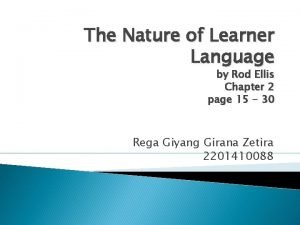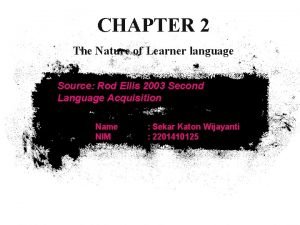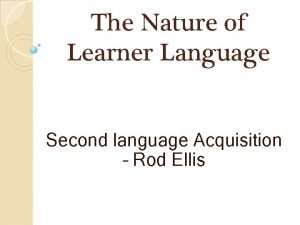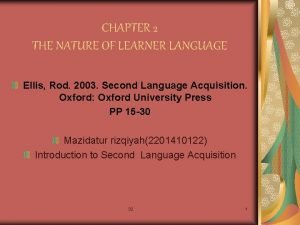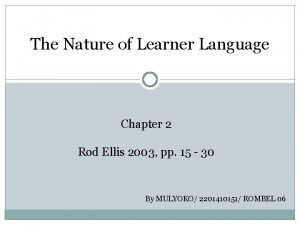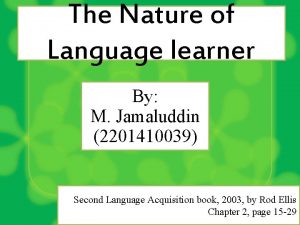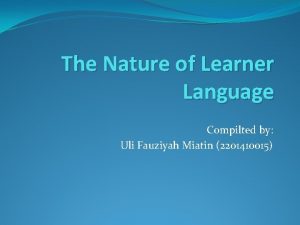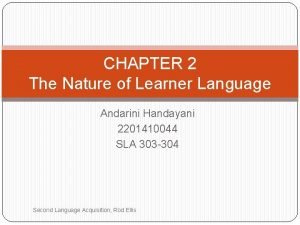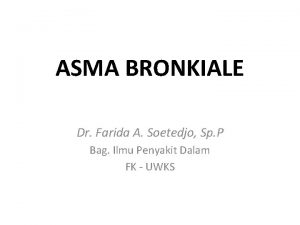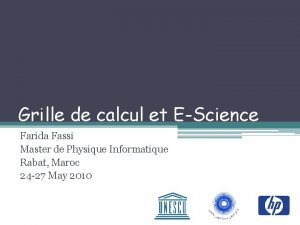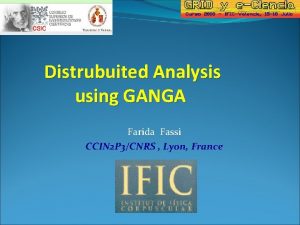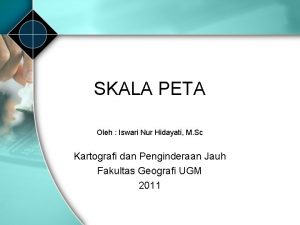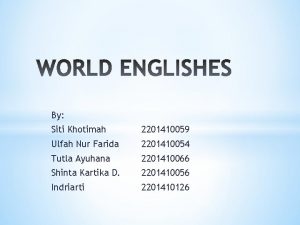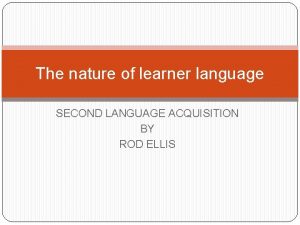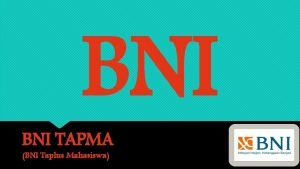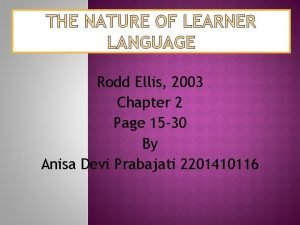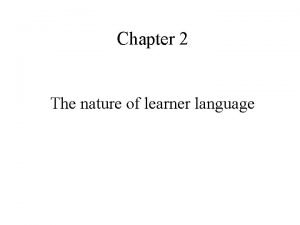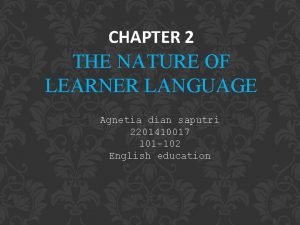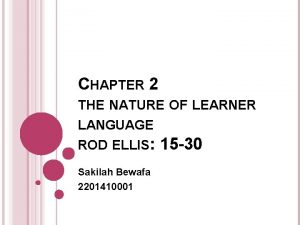The Nature of Learner Language Ulfah Nur Farida


















- Slides: 18

The Nature of Learner Language Ulfah Nur Farida 2201410054 403 -404

Errors and Error Analysis � There are good reasons for focusing on errors First, they are a conspicuous feature of learner language, raising the important question of ‘Why do learners make errors? ’ Second, it is useful for teachers to know what errors learners make Third, paradoxically, it is possible that making errors may actually help learners to learn when they self-correct the errors they make

Analysing Learner Errors Identifying errors Describing errors Explaining errors

Identifying Errors We have to compare the sentences learners produce with what seem to be the normal or ‘corrrect’ sentences in the target language which correspond with them Example : ‘A man and a little boy was watching him’, it should be ‘ a man and a little boy were watching him Distinguish errors and mistakes, by checking the consistency of learners’ performance Example : He wrote ‘the big of them contained a snake’. However, in the last sentence he wrote ‘the basket contain a snake’. Then, it might be considered a mistake

Describing Errors • Gather all the errors relating to verbs • Identify the different kinds of verb errors in our sample Classify errors into grammatical categories Identify general ways in which the learners’ utterances differ from the reconstructed target -language utterances • omission • Misinformation • misordering

Explaining Errors The identification and description of errors are preliminaries to the much more interesting task of trying to explain why they occur Errors are : � Systematic � Some of them universal, and some other not � Have different sources

Error Evaluation Some errors can be considered more serious than others, because they are more likely to interfere with the intelligibility of what someone says Some errors, known as global errors, violatethe overall structure of a sentence and for thiss reason may make it difficult to process Other errors, known as a local errors , affect only a single constituent

Developmental Pattern The early stages of L 2 acquisition : Undergo a silent period. That is, they make no attempt to say anything to begin with Proporsitional simplification, learners find it difficult to speak in full sentences so they frequently leave words out.

� � In time, though, learners do begin to learn the grammar of the L 2. This raises other questions. One concerns the acquisition order. Another question concerns the sequence of acquisition.

The order of acquisition To investigate the order of acquisition, researchers choose a number of grammatical structures to study ( for example, progressive – ing, auxiliary be, and plural –s) They then collect samples of learner language and identify how accurately each feature is used by different learners

Sequence of acquisition When learners acquire a grammatical structure they do so gradually, moving through a series of stages en route to acquiring the native-speaker rule. The acquisition of a particular grammatical structure, therefore, must be seen asa process involving transitional constructions.

Learners are likely to pass through the different stages shown in Table Stage Description Example 1 Learners fail to mark the verb for past time ‘eat’ 2 Learners begin to produce irregular past tense forms ‘ate’ 3 Learners overgeneralize the regular past tense forms ‘eated’ 4 Sometimes learners produce hybrid forms ‘ated’ 5 Learners produce correct irregular past tense forms ‘ate’

Acquisition follows a U-shaped course of development ; that is initially learners may display a high level of accuracy only to apparently regress later before finally once again performing in accordance with targetlanguage norms. As learners restructure their grammatical systems, they may appear to regress whereas in fact they are advancing

Some implications � The discovery of common patterns in the way in which learner language changes over time is one of the most important findings of SLA � It provides further support for the conclusionsreached from the study of learners errors, namely that L 2 acquisition is systemic, to a large extent, universal, reflecting ways in which internal cognitive mechanisms control acquisition, irrespective of the personal background of learners or the setting in which they learn

Variability in learner language At any given stage of development, learners sometimes employ one form an sometimes another. Thus, one type of error may alternate with anither type Yesterday the thief steal the suitcase Yesterday the thief stealing the suitcase Or an error may alternate with the correct target-language form: Yesterday the thief steal the suitcase Yesterday the thief stole the suitcase

Summary • In this section, we have examined a number of properties of learner language and, in so doing, traced the way in which SLA has envolved as a field of enquiry • Early on, researchers focused on leraners’ errors, developing procedures for identifying, describing, explaining, and evaluating them • Subsequently, researchers focused on exploring the regularities of L 2 acquisition by searching for ‘orders’ and ‘sequences’ of acquisition

� • Research on variabilty has sought to show that, although allowance should perhaps be made for some free variation, variability in learner language is systematic Furthermore, variability plays an integrative part in the overall pattern of development, with learners moving through a series of stages that reflect different kinds of variability

Thank You
 Lazy learners vs eager learner
Lazy learners vs eager learner The nature of learner language
The nature of learner language The nature of learner language
The nature of learner language What is the nature of learner
What is the nature of learner The nature of learner language
The nature of learner language The nature of learner language
The nature of learner language The+nature+of+language+learner
The+nature+of+language+learner The nature of learner language
The nature of learner language The nature of learner language
The nature of learner language How to dress like an egyptian
How to dress like an egyptian Asma farida
Asma farida Farida komalasari
Farida komalasari Farida el fassi
Farida el fassi Farida fassi
Farida fassi Nature and nature's laws lay hid in night meaning
Nature and nature's laws lay hid in night meaning Nature nature controversy
Nature nature controversy Spojky souřadící
Spojky souřadící Iswari nur hidayati
Iswari nur hidayati Astria nur irfansyah
Astria nur irfansyah

